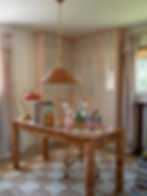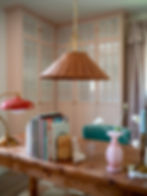DIY Home Office Built-Ins: IKEA Billy Bookcase Hack
- Brit
- Sep 10
- 10 min read
Updated: Sep 12

If you're here it's because you're wondering how I took some basic IKEA Billy Bookcases and turned them into these beautiful built-ins I created for my home office. Well, read on because I'm about to tell you how I did it! It wasn't the easiest DIY I've ever done, but it might be one of the coolest (if I do say so myself).

PAINTING TIPS & ASSEMBLY
First things first, you're going to have to buy your Billy Bookcases and figure out the configuration you want to use. I knew I was going to put them in the corner behind my desk, so I bought two of these and one of these, along with the coinciding height extension units for each one to take them (almost) all the way up to the 8' ceiling. Since I knew I wanted to add doors to hide all the stuff I planned to store in them, I decided to use Oxberg Doors and to make them a little more interesting than solid doors, I got the ones with the glass at the top so I could add grids and curtains. Honestly, that was the hardest part, but also what makes them outstanding.
I'm just going to throw it out there that it took three weeks for IKEA to let me know my shipment wasn't actually going to be delivered after all because the carrier had damaged it. I spoke with their customer service and they helped me find the pieces I needed at the closest store for pickup; however, they weren't all the same finish. This didn't matter to me because I knew I was going to paint them, but if you don't plan to paint, obviously all the pieces will have to be the same finish.



I also want to stress that if you do plan to paint, get the white finish. Not sure the reason behind it, but even after sanding and wiping down both the light and dark "oak effect" pieces, the Zinsser BIN Primer (which sticks to literally everything, I've had nothing but good experiences with it in the past) would not stick. I'd even go as far as to say that the oak effect pieces repelled the primer, which was insane and extremely exasperating. It only worked out because I painted over it and then once it got tacky, painted it again and again and then repeated, if you get what I mean. It took way longer than it should have. But I didn't really have any alternative because I'd already sanded and add primer to the pieces, so it's not like they could be returned. However, the white pieces were just fine. Bizarre, I know ... So get white if you're going to paint!

Also important to note that you're going to want to lay out all the doors and paint the backs and edges of them first before you hang them so you don't have to try to paint around the hardware. After you sand, wipe down, prime with Zinsser BIN primer and then use a nice quality enamel or cabinet paint (I used Sherwin-Williams Eurethane Trim Enamel in Beige), THEN install your doors. But before you install the doors, also sand, wipe down, prime, and paint your shelves first. If you're going to put them in a corner, make sure you do that before you install the doors too.

A little note on that ... If you put the shelves in a corner, you're going to have to add a 1x4x8 piece of poplar or pine (something smooth) to the side of at least one of the corner shelves to allow room for the doors to open without hitting each other (see above). Ideally, you should add one to each side and then use contruction adhesive to glue them together in the middle. I only used one on the left side and the door to the left of it opens a full 90 degrees, but the door to the right of it stops just short of 90 when I open it. It doesn't bother me in the least, but if that would bother you, I'd modify and add a piece to each!

Before attaching the 1x4, I measured the height of the Billy Bookcase along with the height extender and cut it, then painted it. I attached it with construction adhesive and clamps and then added pin nails to give it a little extra staying power. To attach it to the shelf to the right of it, I added construction adhesive and pushed it into place so that it and the side of the shelf on the right overlapped each other about an inch. To attach the two Billy Bookcases I used on the right side of the corner, I put construction adhesive on the sides and clamped them together.
Once I had them in place and glued together, I added the decorative crown moulding to the ceiling, which I painted first. I used dentil moulding that would sit flat on the ceiling in between it and the top of the shelves. What I got was a little too wide, so my husband ripped it for me with the table saw to make it fit. Once the pieces fit, we (the royal we, meaning my husband) cut the angles so they'd fit the corners of the shelves, which proved to be a bit tricky. Apparently, you have to use compound miter cuts. I found this out the hard way after cutting a piece and realizing it wasn't going to work. You can't just set the saw at a 45 degree angle and cut like you can with trim or wall moulding or whatever. Now, I'll admit this was something I just didn't have any desire to learn whatsoever, so I let Derek figure it out and do it. This is a really good explanation of how to do it yourself though!


Once the moulding was cut and sadly spliced together in one spot because of my cutting mistake (I wasn't about to spend another $50 and the time to go get another piece too when it wouldn't be noticeable when it was all said and done), I used pin nails to attach the crown moulding to the ceiling and then caulk to fill the cracks between it and the shelves. I also caulked all the seams between the shelves in the corner and where I'd attached the two on the right side, as well as the cracks between the shelves and the wall.



After I had everything put together and caulked, I went back and touched up all the paint and painted over the caulked seams. Then I installed all the doors and painted the fronts of them after they were up. Of course, I sanded, wiped down, and primed them all first. One thing I will say is that taping off the windows was a total waste of time for me. What happened was that the tape ended up pulling off the paint in spots around the windows of all the pieces except the white ones (and I only had two white doors). And that was even with slicing around the edges with a razor blade before pulling the tape in an attempt to prevent that from happening.

So if I were to do the project over again, I might try some of that stuff you can buy and paint on the window first to see if it works (never used it before) OR I'd just paint on the window and then scrape it off with a razor blade. If you slice around the edge with the blade and then scrape the painted part with the razor blade edge on the glass and at a slight angle, it actually comes off pretty easily.

I will say that I used primer first, scraped it right away and then painted and scraped it as soon as it was dry enough. I wouldn't layer a bunch of primer and paint on and let it sit for several days and then scrape or I suspect it would be a lot harder. Yes, it was a bit of a pain, but it depends on what you're willing to do to get that finished look, I guess. I taped all the windows off and then ended up having to touch up around all of them (except the white ones) and then scrape the paint off anyway. So it would've saved me A LOT of time if I hadn't bothered with the tape in the first place. Now, if you get all white doors there's a chance you could tape the windows off and it would be fine, but that's totally up to you! Just relaying my experience. It was a bit of an ordeal.

WINDOW GRIDS
Once you're done with all that you could be done! If you want the gridded window look or the curtains though, keep reading! So for the grids, I wanted them to actually be wood (not tape or whatever I've seen people do) and to get wood pieces that matched the depth of the edge around the glass of the windows, we (i.e., Derek) had to rip it to size. I used 1x4x8 pieces of poplar - and I stress poplar as opposed to pine because I actually used both and the poplar didn't try to splinter like the pine did when I used the miter saw on it to cut all the little grid pieces.
So once we ripped the 1x4s into 1/8" thick pieces, I had to cut to size all the pieces I'd need for my grid design. I want to say that Derek ripped probably four or so 1x4s into as many 1/8" slices he could safely get from each one (maybe 12-14 or so each). I wasn't really planning to do a blog post about it at the time, so I didn't count the exact numbers. I can tell you exactly how many pieces I ended up using to make the grids and their exact measurements though!

I will also note that I did paint them all first before cutting them into tiny pieces because I didn't want a repeat of what happened with painting around the windows. And painting one long piece is way faster than a bunch of little ones! I painted the backs and sides of each piece. I'd definitely recommend painting the backs because you can see them through the glass even if you add the design to the front and back of each window like I did. You could also paint the fronts, but I didn't bother and did it after they were glued in place.

I added the grid design to the front AND back of each window, but whether you add it to the back is totally up to you. Once you glue the pieces in place you can see the glue even though it's clear. I was mildly curious what it would look like and if it would work out putting the design on both sides, which is why I did it that way. BUT if you're covering the insides with curtains like I did, it really isn't necessary and is twice the work.





If you add the design to just the outside of the window, you need two 35 13/16" pieces, eight 3 1/4" pieces, and four 3 3/4" pieces for each full length door. If you do the inside as well, double it. For the small doors on the height extensions, you need two 10 1/4" pieces, four 3 1/4" pieces, and two 3 3/4" pieces for the outside of each one. If you do both sides, double it.

For placement, I added the four 3 1/4" corner pieces first (pink above), using Loctite Extreme Glue. I measured to make sure they were straight and taped them in place so they wouldn't slide.Then I did the two 35 13/16" vertical pieces (blue), and then the 3 3/4" pieces (red) in the center for each one. Once they dried, I went back and added the second set of pieces (gold). I repeated this for all the doors and then went back and did the insides of the windows the same way. For the upper doors, it was the same process with shorter vertical pieces and no second set. Once the glue was dried, I painted all the grids.

CURTAINS
The next day, I started on the curtains. I used electrical conduit brackets to hold the 1/2" wooden dowels I used as curtain rods in place. If I did it again, I might try to use 1/4" dowels if I could find smaller brackets as well because the distance they stick out from the door inside the cabinet cuts into the depth of what I can put on the (already not very deep) shelves where they're placed, if that makes sense. Since I had ten windows to cover, I needed 40 brackets and 20 dowels. I painted all the dowels and brackets first (the dowels I painted the color of the cabinets and the brackets I spray painted gold). Then I cut the dowels, with each one being 14" long.


I cut up two linen curtains from Target for the curtains themselves. For the long windows, I cut each curtain 42" long by 28" wide so I could add some pleats. For the smaller windows at the top, I used pieces that were 16" long by 28" wide. I made sure to use a level as I installed the rods and then tucked the curtains in place. The rods sit close enough to the door that they held the curtains in place while I adjusted them to look how I wanted.

Once I got them in place, I wrapped them around the rods and glued them in place. I used Fabric Fusion, but would recommend Liquid Stitch. Fabric Fusion dries clear and then six months later shows up again, but I've been told Liquid Stitch doesn't do that. Granted, I could have figured out exact measurements to ensure the curtain stretched perfectly between the rods and then sewed rod pockets and went to all that trouble, but I hate sewing and got the same look with glue and it was way faster and easier. After all the work I'd already put into this project, I didn't want to spend any extra time if I didn't have to! That's just me though! If you'd prefer to sew rod pockets, have at it!


And that, my friends, is pretty much it! I wouldn't say this was a quick and easy DIY by any means with all the steps involved, but I would say it was 100% worth it for the finished look and I'd do it again (possibly with a few modifications
as mentioned above) in a heartbeat! If you have any questions at all, feel free to hit me up on Instagram or email me at hello@britdotdesign.com. Always happy to help!
GET THE FINAL LOOK:


